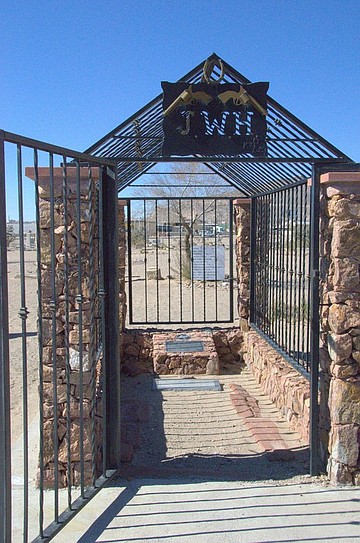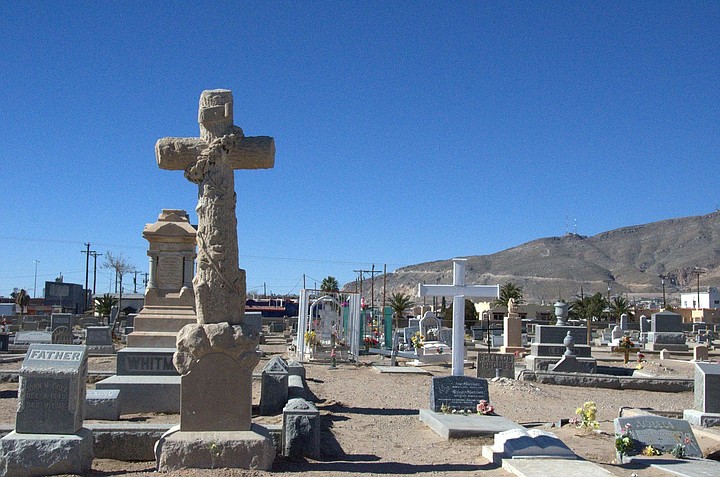 Facebook
Facebook
 X
X
 Instagram
Instagram
 TikTok
TikTok
 Youtube
Youtube

I’ve never considered visiting graveyards a “must-see” travel experience, but I’ll have to admit that lately I am finding a wealth of history and a deep sense of place that develops necessarily when jaunting graveyard sites.
This is particularly true in El Paso, Texas.
Concordia Cemetery is a starkly desolate, almost lunar-like landscape where the high desert winds howl and fine dust soars from all directions – sometimes all at once.
With the Mexican border only a few blocks away, the cemetery holds the keys to an understanding of El Paso at the crossroads, not only geographically but from an ethnic and cultural standpoint. For buried on these hallowed grounds are the inclusive remains of El Paso’s history – a colorful chronicle that began with Spanish conquistadors, progressed to Mexican dominion, then further to an infamous town of Western ambitions and lawless pursuits, finally becoming a part of Texas and the United States.
To better understand the city's patchwork, it helps to roam the graves of those that have gone before. With over 60,000 inhabitants – all of them dead – and confined to 52 acres, the Concordia graveyard is permanent record of El Paso's cultural and historical kaleidoscope.
The Notorious Inhabitant of “Boot Hill”

Most visitors head straight to the grave of John Wesley Hardin (left), a gunslinger, gambler and outlaw so famous, that he reputedly killed more people than Billy the Kid and Jesse James. Ironically, he did not view himself in the same light and has been quoted as explaining his killing spree as only doing right.
“I never killed anyone who didn’t need killing,” rationalized Hardin regarding the 42 people he claimed to have murdered before his imprisonment at the Huntsville, Texas, prison.
While in prison, he studied law and passed the Texas state bar shortly after being released in 1893, where he would then move to El Paso to practice law.
Unfortunately, Hardin quickly reverted back to gambling and drinking, and was shot in the back of the head at the Acme Saloon by John Selman, a man who also found himself on both sides of the law at various times. The date was August 19, 1895.
Almost a century later in 1995, Hardin’s descendants would approach the court for permission to dig up his remains and reinter them in Nixon, Texas. A judge eventually ruled that Hardin’s remains will stay in El Paso.
A Most Diverse Graveyard
In the 1840s, this area was known as Rancho Concordia and was home to a trader. It eventually became the final resting spot for his wife, after she met her untimely death when gored by a pet deer.
By the 1880s, the place was a popular spot for people from El Paso – just three miles away – to bring and bury their dead. Proximity to the growing city was the key. This led to the city purchasing its first cemetery parcel in 1882 as a burial ground for paupers. By the 1890s, sections were purchased by various groups.

Different sections include: Jesuit, Catholic, Mormon, Masonic, Jewish, African-American, Buffalo Soldiers (left), Chinese and Military.
There’s even a “children’s” section where it is rumored that the bodies of numerous children were buried after a severe outbreak of smallpox. Today, the area is eerily marked by a somewhat dilapidated iron crib.
Many Chinese buried in El Paso are the men and their families who helped build the intercontinental railroad and decided to stay in El Paso, making it their permanent home.
However, with the introduction of the Chinese Exclusion Act in 1882, immigration from Asia was severely restricted, causing many Chinese men to marry Mexican women when they were unable to bring their wives and families to the states. As a result, it’s not uncommon today to see mixed Chinese and Hispanic names within El Paso.
Haunted Concordia and More
By the 1960s, the graveyard fell into a sad state of disrepair. Much of this could be attributed to the fact that the Concordia was a patchwork quilt of privately owned, publicly owned, and some non-owned burial grounds with no one entity accepting responsibility for ground repairs and maintenance.
Now run by the Concordia Heritage Association, a 501(c)3 organization determined to preserve El Paso’s legacy and heritage, they – through a largely volunteer basis – have accepted the challenge to save this historical piece of land.
Special events include Dia de los Muertos (Day of the Dead), monthly ghost tours, and the annual meeting of the John Wesley Hardin Secret Society.

Though Concordia is open from sunup to sundown, it is best to confine your sojourns to early morning or late afternoon. Otherwise, the intense dry heat will take a toll. Be sure to bring drinking water and wear a hat for shade, as the graveyard is bone-dry with almost no greenery or shade available.
If you visit the bone yard in the morning, plan on stopping for lunch at L&J Café for a slice of local mania and some really good food.
Known also as “the old place by the graveyard,” it’s been in the same place since 1927. At that time it was considered to be on the outskirts of town. However, as El Paso has grown, Concordia Cemetery and L&J Café are now in the center of the city, at today’s I-10 “Spaghetti Bowl” interchange.


I’ve never considered visiting graveyards a “must-see” travel experience, but I’ll have to admit that lately I am finding a wealth of history and a deep sense of place that develops necessarily when jaunting graveyard sites.
This is particularly true in El Paso, Texas.
Concordia Cemetery is a starkly desolate, almost lunar-like landscape where the high desert winds howl and fine dust soars from all directions – sometimes all at once.
With the Mexican border only a few blocks away, the cemetery holds the keys to an understanding of El Paso at the crossroads, not only geographically but from an ethnic and cultural standpoint. For buried on these hallowed grounds are the inclusive remains of El Paso’s history – a colorful chronicle that began with Spanish conquistadors, progressed to Mexican dominion, then further to an infamous town of Western ambitions and lawless pursuits, finally becoming a part of Texas and the United States.
To better understand the city's patchwork, it helps to roam the graves of those that have gone before. With over 60,000 inhabitants – all of them dead – and confined to 52 acres, the Concordia graveyard is permanent record of El Paso's cultural and historical kaleidoscope.
The Notorious Inhabitant of “Boot Hill”

Most visitors head straight to the grave of John Wesley Hardin (left), a gunslinger, gambler and outlaw so famous, that he reputedly killed more people than Billy the Kid and Jesse James. Ironically, he did not view himself in the same light and has been quoted as explaining his killing spree as only doing right.
“I never killed anyone who didn’t need killing,” rationalized Hardin regarding the 42 people he claimed to have murdered before his imprisonment at the Huntsville, Texas, prison.
While in prison, he studied law and passed the Texas state bar shortly after being released in 1893, where he would then move to El Paso to practice law.
Unfortunately, Hardin quickly reverted back to gambling and drinking, and was shot in the back of the head at the Acme Saloon by John Selman, a man who also found himself on both sides of the law at various times. The date was August 19, 1895.
Almost a century later in 1995, Hardin’s descendants would approach the court for permission to dig up his remains and reinter them in Nixon, Texas. A judge eventually ruled that Hardin’s remains will stay in El Paso.
A Most Diverse Graveyard
In the 1840s, this area was known as Rancho Concordia and was home to a trader. It eventually became the final resting spot for his wife, after she met her untimely death when gored by a pet deer.
By the 1880s, the place was a popular spot for people from El Paso – just three miles away – to bring and bury their dead. Proximity to the growing city was the key. This led to the city purchasing its first cemetery parcel in 1882 as a burial ground for paupers. By the 1890s, sections were purchased by various groups.

Different sections include: Jesuit, Catholic, Mormon, Masonic, Jewish, African-American, Buffalo Soldiers (left), Chinese and Military.
There’s even a “children’s” section where it is rumored that the bodies of numerous children were buried after a severe outbreak of smallpox. Today, the area is eerily marked by a somewhat dilapidated iron crib.
Many Chinese buried in El Paso are the men and their families who helped build the intercontinental railroad and decided to stay in El Paso, making it their permanent home.
However, with the introduction of the Chinese Exclusion Act in 1882, immigration from Asia was severely restricted, causing many Chinese men to marry Mexican women when they were unable to bring their wives and families to the states. As a result, it’s not uncommon today to see mixed Chinese and Hispanic names within El Paso.
Haunted Concordia and More
By the 1960s, the graveyard fell into a sad state of disrepair. Much of this could be attributed to the fact that the Concordia was a patchwork quilt of privately owned, publicly owned, and some non-owned burial grounds with no one entity accepting responsibility for ground repairs and maintenance.
Now run by the Concordia Heritage Association, a 501(c)3 organization determined to preserve El Paso’s legacy and heritage, they – through a largely volunteer basis – have accepted the challenge to save this historical piece of land.
Special events include Dia de los Muertos (Day of the Dead), monthly ghost tours, and the annual meeting of the John Wesley Hardin Secret Society.

Though Concordia is open from sunup to sundown, it is best to confine your sojourns to early morning or late afternoon. Otherwise, the intense dry heat will take a toll. Be sure to bring drinking water and wear a hat for shade, as the graveyard is bone-dry with almost no greenery or shade available.
If you visit the bone yard in the morning, plan on stopping for lunch at L&J Café for a slice of local mania and some really good food.
Known also as “the old place by the graveyard,” it’s been in the same place since 1927. At that time it was considered to be on the outskirts of town. However, as El Paso has grown, Concordia Cemetery and L&J Café are now in the center of the city, at today’s I-10 “Spaghetti Bowl” interchange.
Comments